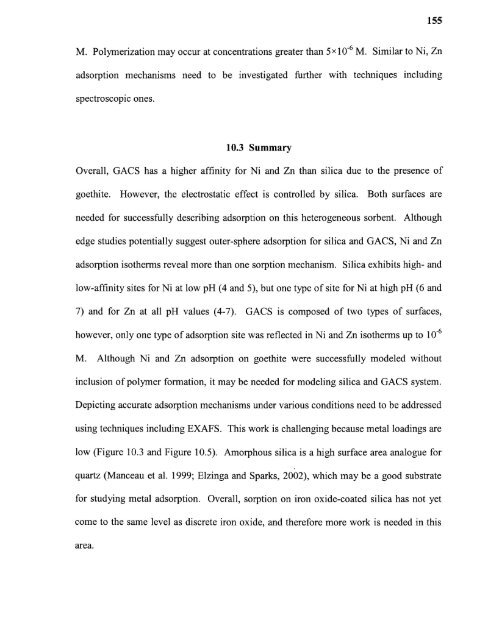Heavy metal adsorption on iron oxide and iron oxide-coated silica ...
Heavy metal adsorption on iron oxide and iron oxide-coated silica ...
Heavy metal adsorption on iron oxide and iron oxide-coated silica ...
You also want an ePaper? Increase the reach of your titles
YUMPU automatically turns print PDFs into web optimized ePapers that Google loves.
155M. Polymerizati<strong>on</strong> may occur at c<strong>on</strong>centrati<strong>on</strong>s greater than 5x10 -6 M. Similar to Ni, Zn<str<strong>on</strong>g>adsorpti<strong>on</strong></str<strong>on</strong>g> mechanisms need to be investigated further with techniques includingspectroscopic <strong>on</strong>es.10.3 SummaryOverall, GACS has a higher affinity for Ni <strong>and</strong> Zn than <strong>silica</strong> due to the presence ofgoethite. However, the electrostatic effect is c<strong>on</strong>trolled by <strong>silica</strong>. Both surfaces areneeded for successfully describing <str<strong>on</strong>g>adsorpti<strong>on</strong></str<strong>on</strong>g> <strong>on</strong> this heterogeneous sorbent. Althoughedge studies potentially suggest outer-sphere <str<strong>on</strong>g>adsorpti<strong>on</strong></str<strong>on</strong>g> for <strong>silica</strong> <strong>and</strong> GACS, Ni <strong>and</strong> Zn<str<strong>on</strong>g>adsorpti<strong>on</strong></str<strong>on</strong>g> isotherms reveal more than <strong>on</strong>e sorpti<strong>on</strong> mechanism. Silica exhibits high- <strong>and</strong>low-affinity sites for Ni at low pH (4 <strong>and</strong> 5), but <strong>on</strong>e type of site for Ni at high pH (6 <strong>and</strong>7) <strong>and</strong> for Zn at all pH values (4-7). GACS is composed of two types of surfaces,however, <strong>on</strong>ly <strong>on</strong>e type of <str<strong>on</strong>g>adsorpti<strong>on</strong></str<strong>on</strong>g> site was reflected in Ni <strong>and</strong> Zn isotherms up to 10 -6M. Although Ni <strong>and</strong> Zn <str<strong>on</strong>g>adsorpti<strong>on</strong></str<strong>on</strong>g> <strong>on</strong> goethite were successfully modeled withoutinclusi<strong>on</strong> of polymer formati<strong>on</strong>, it may be needed for modeling <strong>silica</strong> <strong>and</strong> GACS system.Depicting accurate <str<strong>on</strong>g>adsorpti<strong>on</strong></str<strong>on</strong>g> mechanisms under various c<strong>on</strong>diti<strong>on</strong>s need to be addressedusing techniques including EXAFS. This work is challenging because <str<strong>on</strong>g>metal</str<strong>on</strong>g> loadings arelow (Figure 10.3 <strong>and</strong> Figure 10.5). Amorphous <strong>silica</strong> is a high surface area analogue forquartz (Manceau et al. 1999; Elzinga <strong>and</strong> Sparks, 2002), which may be a good substratefor studying <str<strong>on</strong>g>metal</str<strong>on</strong>g> <str<strong>on</strong>g>adsorpti<strong>on</strong></str<strong>on</strong>g>. Overall, sorpti<strong>on</strong> <strong>on</strong> ir<strong>on</strong> <strong>oxide</strong>-<strong>coated</strong> <strong>silica</strong> has not yetcome to the same level as discrete ir<strong>on</strong> <strong>oxide</strong>, <strong>and</strong> therefore more work is needed in thisarea.
















